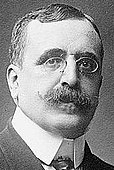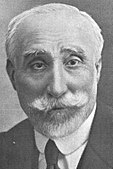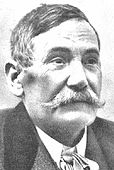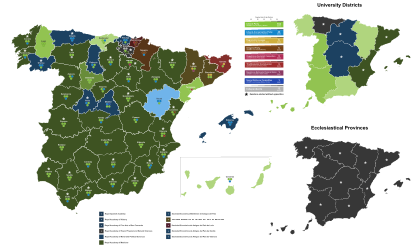1910 Spanish general election
 From Wikipedia - Reading time: 13 min
From Wikipedia - Reading time: 13 min
| |||||||||||||||||||||||||||||||||||||||||||||||||||||||||||||||||||||||||||||
All 404 seats in the Congress of Deputies and 180 (of 360) seats in the Senate 203 seats needed for a majority in the Congress of Deputies | |||||||||||||||||||||||||||||||||||||||||||||||||||||||||||||||||||||||||||||
|---|---|---|---|---|---|---|---|---|---|---|---|---|---|---|---|---|---|---|---|---|---|---|---|---|---|---|---|---|---|---|---|---|---|---|---|---|---|---|---|---|---|---|---|---|---|---|---|---|---|---|---|---|---|---|---|---|---|---|---|---|---|---|---|---|---|---|---|---|---|---|---|---|---|---|---|---|---|
| |||||||||||||||||||||||||||||||||||||||||||||||||||||||||||||||||||||||||||||
| |||||||||||||||||||||||||||||||||||||||||||||||||||||||||||||||||||||||||||||
The 1910 Spanish general election was held on Sunday, 8 May (for the Congress of Deputies)[a] and on Sunday, 22 May 1910 (for the Senate),[b] to elect the 14th Cortes of the Kingdom of Spain in the Restoration period. All 404 seats in the Congress of Deputies were up for election, as well as 180 of 360 seats in the Senate.
Overview
[edit]Electoral system
[edit]The Spanish Cortes were envisaged as "co-legislative bodies", based on a nearly perfect bicameral system. Both the Congress of Deputies and the Senate had legislative, control and budgetary functions, sharing equal powers except for laws on contributions or public credit, where the Congress had preeminence.[3][4] Voting for the Cortes was on the basis of universal manhood suffrage, which comprised all national males over 25 years of age, having at least a two-year residency in a municipality and in full enjoyment of their civil rights. Amendments to the electoral law in 1907 introduced compulsory voting, though those older than 70, the clergy, first instance judges and public notaries were exempt from this obligation.[5][6]
For the Congress of Deputies, 98 seats were elected using a partial block voting system in 28 multi-member constituencies, with the remaining 306 being elected under a one-round first-past-the-post system in single-member districts. Candidates winning a plurality in each constituency were elected. In constituencies electing ten seats or more, electors could vote for no more than four candidates less than the number of seats to be allocated; in those with more than eight seats and up to ten, for no more than three less; in those with more than four seats and up to eight, for no more than two less; in those with more than one seat and up to four, for no more than one less; and for one candidate in single-member districts. Additionally, in those districts where the number of candidates was equal or less than the number of seats up for election, candidates were to be automatically elected. The Congress was entitled to one member per each 50,000 inhabitants, with each multi-member constituency being allocated a fixed number of seats. The law also provided for by-elections to fill seats vacated throughout the legislature.[3][7][8][9]
As a result of the aforementioned allocation, each Congress multi-member constituency was entitled the following seats:[8][10][11][12][13][14][15][16][17]
| Seats | Constituencies |
|---|---|
| 8 | Madrid |
| 7 | Barcelona |
| 5 | Palma, Seville |
| 4 | Cartagena |
| 3 | Alicante, Almería, Badajoz, Burgos, Cádiz, Córdoba, Granada, Huelva, Jaén, Jerez de la Frontera, La Coruña, Las Palmas, Lugo, Málaga, Murcia, Oviedo, Pamplona, Santa Cruz de Tenerife, Santander, Tarragona, Valencia, Valladolid, Zaragoza |
For the Senate, 180 seats were indirectly elected by the local councils and major taxpayers, with electors voting for delegates instead of senators. Elected delegates—equivalent in number to one-sixth of the councillors in each local council—would then vote for senators using a write-in, two-round majority voting system. The provinces of Barcelona, Madrid and Valencia were allocated four seats each, whereas each of the remaining provinces was allocated three seats, for a total of 150. The remaining 30 were allocated to special districts comprising a number of institutions, electing one seat each—the archdioceses of Burgos, Granada, Santiago de Compostela, Seville, Tarragona, Toledo, Valencia, Valladolid and Zaragoza; the Royal Spanish Academy; the royal academies of History, Fine Arts of San Fernando, Exact and Natural Sciences, Moral and Political Sciences and Medicine; the universities of Madrid, Barcelona, Granada, Oviedo, Salamanca, Santiago, Seville, Valencia, Valladolid and Zaragoza; and the economic societies of Friends of the Country from Madrid, Barcelona, León, Seville and Valencia. An additional 180 seats comprised senators in their own right—the Monarch's offspring and the heir apparent once coming of age; Grandees of Spain of the first class; Captain Generals of the Army and the Navy Admiral; the Patriarch of the Indies and archbishops; and the presidents of the Council of State, the Supreme Court, the Court of Auditors, the Supreme War Council and the Supreme Council of the Navy, after two years of service—as well as senators for life (who were appointed by the Monarch).[3][18][19]
Election date
[edit]The term of each chamber of the Cortes—the Congress and one-half of the elective part of the Senate—expired five years from the date of their previous election, unless they were dissolved earlier. The previous Congress and Senate elections were held on 21 April and 5 May 1907, which meant that the legislature's terms would have expired on 21 April and 5 May 1912, respectively. The monarch had the prerogative to dissolve both chambers at any given time—either jointly or separately—and call a snap election.[3][8][18] There was no constitutional requirement for concurrent elections to the Congress and the Senate, nor for the elective part of the Senate to be renewed in its entirety except in the case that a full dissolution was agreed by the monarch. Still, there was only one case of a separate election (for the Senate in 1877) and no half-Senate elections taking place under the 1876 Constitution.
The Cortes were officially dissolved on 14 April 1910, with the dissolution decree setting the election dates for 8 May (for the Congress) and 22 May 1910 (for the Senate) and scheduling for both chambers to reconvene on 15 June.[20]
Background
[edit]The Spanish Constitution of 1876 enshrined Spain as a constitutional monarchy, awarding the monarch the right of legislative initiative together with the bicameral Cortes; the capacity to veto laws passed by the legislative body; the power to appoint senators and government ministers; as well as the title of commander-in-chief of the army and navy. The monarch would play a key role in the system of el turno pacífico (English: the Peaceful Turn) by appointing and dismissing governments and allowing the opposition to take power. Under this informal system, the major political parties at the time, the Conservatives and the Liberals—characterized as elite parties with loose structures dominated by internal factions, each led by powerful individuals—alternated in power by means of election rigging, which they achieved through the encasillado, assignating the seats in the general elections before they were held by using the links between the Ministry of Governance, the provincial civil governors and the local bosses (caciques) to ensure victory and exclude minor parties from the power sharing.[21][22] The result was "a liberal system without democracy".[23]
Results
[edit]Congress of Deputies
[edit] | ||||||
| Parties and alliances | Popular vote | Seats | ||||
|---|---|---|---|---|---|---|
| Votes | % | A.29 | Cont. | Total | ||
| Monarchist Democratic Party–Liberal Party (PDM–PL) | 70 | 154 | 224 | |||
| Liberal Conservative Party (PLC) | 38 | 71 | 109 | |||
| Republican–Socialist Conjunction (CRS) | 3 | 26 | 29 | |||
| Republican Nationalist Federal Union (UFNR) | 0 | 10 | 10 | |||
| Traditionalist Communion (Jaimist) (CT) | 3 | 7 | 10 | |||
| Regionalist League (LR) | 2 | 6 | 8 | |||
| Integrist Party (PI) | 1 | 2 | 3 | |||
| Autonomist Republican Union Party (PURA) | 0 | 2 | 2 | |||
| Independents (INDEP) | 2 | 7 | 9 | |||
| Total | 119 | 285 | 404 | |||
| Votes cast / turnout | ||||||
| Abstentions | ||||||
| Registered voters | ||||||
| Sources[a][24][25][26][27][28][29] | ||||||
Senate
[edit]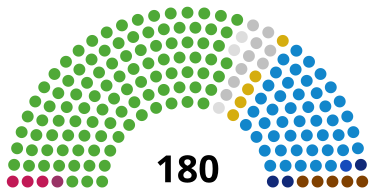 | ||
| Parties and alliances | Seats | |
|---|---|---|
| Monarchist Democratic Party–Liberal Party (PDM–PL) | 104 | |
| Liberal Conservative Party (PLC) | 46 | |
| Integrist Party (PI) | 5 | |
| Regionalist League (LR) | 5 | |
| Republican–Socialist Conjunction (CRS) | 3 | |
| Traditionalist Communion (Jaimist) (CT) | 3 | |
| Republican Nationalist Federal Union (UFNR) | 1 | |
| Social Defence Committee (CDS) | 1 | |
| Independents (INDEP) | 3 | |
| Archbishops (ARCH) | 9 | |
| Total elective seats | 180 | |
| Sources[b][30][31][32][33][34][35][36] | ||
Distribution by group
[edit]| Group | Parties and alliances | C | S | Total | ||
|---|---|---|---|---|---|---|
| PDM–PL | Monarchist Democratic Party–Liberal Party (PDM–PL) | 221 | 102 | 328 | ||
| Basque Dynastics (Urquijist) (DV) | 1 | 2 | ||||
| Monarchist Coalition (MON) | 2 | 0 | ||||
| PLC | Liberal Conservative Party (PLC) | 108 | 45 | 155 | ||
| Anti-Liberal Catholic Alliance (ACA) | 1 | 1 | ||||
| CRS | Republican Union Party (PUR) | 14 | 2 | 32 | ||
| Radical Republican Party (PRR) | 11 | 0 | ||||
| Federal Republican Party (PRF) | 3 | 1 | ||||
| Spanish Socialist Workers' Party (PSOE) | 1 | 0 | ||||
| CT | Traditionalist Communion (Jaimist) (CT) | 5 | 3 | 13 | ||
| Anti-Liberal Catholic Alliance (ACA) | 5 | 0 | ||||
| LR | Regionalist League (LR) | 8 | 5 | 13 | ||
| UFNR | Republican Nationalist Federal Union (UFNR) | 10 | 1 | 11 | ||
| PI | Integrist Party (PI) | 2 | 3 | 8 | ||
| Anti-Liberal Catholic Alliance (ACA) | 1 | 2 | ||||
| PURA | Autonomist Republican Union Party (PURA) | 2 | 0 | 2 | ||
| CDS | Social Defence Committee (CDS) | 0 | 1 | 1 | ||
| INDEP | Independents (INDEP) | 7 | 3 | 12 | ||
| Independent Catholics (CAT) | 2 | 0 | ||||
| ARCH | Archbishops (ARCH) | 0 | 9 | 9 | ||
| Total | 404 | 180 | 584 | |||
See also
[edit]Notes
[edit]- ^ a b c Congress candidates elected automatically under Article 29 of the Electoral Law were proclaimed on 1 May 1910.[1]
- ^ a b c The Senate election in the province of the Canary Islands was postponed to 27 May 1910.[2]
- ^ Results for PL (72 deputies and 25 senators) and PDM (7 deputies and 6 senators) in the 1907 election.
- ^ Results for PUR, not including Catalonia (15 deputies and 1 senator), and RAS (2 deputies and 1 senator) in the 1907 election.
- ^ Results for PRF (9 deputies and 3 senators), PUR in Catalonia (5 deputies and 2 senators) and CNR (4 deputies and 0 senators) in the 1907 election.
References
[edit]- ^ "Mayo de 1910. Día 1. Diputados elegidos por el art. 29". National Library of Spain (in Spanish). El Año Político. 1 January 1911. Retrieved 30 November 2022.
- ^ "Senadores por Canarias". National Library of Spain (in Spanish). La Época. 28 May 1910. Retrieved 18 December 2022.
- ^ a b c d Constitución de la Monarquía Española (PDF) (Constitution) (in Spanish). 30 June 1876. Retrieved 19 August 2022.
- ^ "El Senado en la historia constitucional española". Senate of Spain (in Spanish). Retrieved 26 December 2016.
- ^ García Muñoz 2002, pp. 107–108.
- ^ Carreras de Odriozola & Tafunell Sambola 2005, p. 1077.
- ^ Ley electoral de los Diputados a Cortes (PDF) (Law) (in Spanish). 28 December 1878. Retrieved 19 August 2022.
- ^ a b c Ley reformando la Electoral vigente (PDF) (Law) (in Spanish). 8 August 1907. Retrieved 28 November 2022.
- ^ Ley mandando que los distritos para las elecciones de Diputados á Córtes sean los que se expresan en la división adjunta (PDF) (Law) (in Spanish). 1 January 1871. Retrieved 21 August 2022.
- ^ Ley dividiendo la provincia de Guipúzcoa en distritos para la elección de Diputados a Cortes (PDF) (Law) (in Spanish). 23 June 1885. Retrieved 6 May 2023.
- ^ Ley dividiendo el distrito electoral de Tarrasa en dos, que se denominarán de Tarrasa y de Sabadell (PDF) (Law) (in Spanish). 18 January 1887. Retrieved 6 May 2023.
- ^ Ley fijando la división de la provincia de Alava en distritos electorales para Diputados á Cortes (PDF) (Law) (in Spanish). 10 July 1888. Retrieved 6 May 2023.
- ^ Leyes aprobando la división electoral de las provincias de León y Vizcaya (PDF) (Law) (in Spanish). 2 August 1895. Retrieved 6 May 2023.
- ^ Leyes aprobando la división electoral en las provincias de Sevilla y de Barcelona (PDF) (Law) (in Spanish). 5 July 1898. Retrieved 22 September 2022.
- ^ Ley mandando que en lo sucesivo sean cuatro los Diputados á Cortes que elegirá la circunscripción electoral de Cartagena (PDF) (Law) (in Spanish). 7 August 1899. Retrieved 10 October 2022.
- ^ Ley estableciendo una circunscripción para elegir tres Diputados á cortes, que la constituirán los cuatro partidos judiciales de Ayamonte, Hueva, Moguer y la Palma, con todas las poblaciones que de ellos forman parte (PDF) (Law) (in Spanish). 24 March 1902. Retrieved 30 October 2022.
- ^ Ley sancionada por S. M. formando un solo distrito electoral para Diputados á Cortes con los de Las Palmas y Guía (PDF) (Law) (in Spanish). 5 April 1904. Retrieved 1 November 2022.
- ^ a b Ley electoral de Senadores (PDF) (Law) (in Spanish). 8 February 1877. Retrieved 19 August 2022.
- ^ "Real decreto disponiendo el número de Senadores que han de elegir las provincias que se citan" (PDF). Gaceta de Madrid (in Spanish) (76). Agencia Estatal Boletín Oficial del Estado: 1021. 16 March 1899.
- ^ "Real decreto declarando disueltos el Congreso de los Diputados y la parte electiva del Senado, y disponiendo que las Cortes se reúnan en Madrid el 15 de Junio próximo, y que las elecciones de Diputados y Senadores se verifiquen el 8 y 22 de Mayo próximo, respectivamente" (PDF). Gaceta de Madrid (in Spanish) (105). Agencia Estatal Boletín Oficial del Estado: 110. 15 April 1910.
- ^ Martorell Linares 1997, pp. 139–143.
- ^ Martínez Relanzón 2017, pp. 147–148.
- ^ "La Restauración borbónica. Implantación y afianzamiento de un nuevo sistema político (1874-1902)". TocaSociales.com (in Spanish). Retrieved 4 January 2025.
- ^ "El resultado de las elecciones". National Library of Spain (in Spanish). El Heraldo de Madrid. 9 May 1910. Retrieved 30 November 2022.
- ^ "Datos oficiales de toda España". National Library of Spain (in Spanish). La Mañana. 9 May 1910. Retrieved 30 November 2022.
- ^ "Las elecciones". National Library of Spain (in Spanish). El Globo. 9 May 1910. Retrieved 30 November 2022.
- ^ "Las elecciones generales". National Library of Spain (in Spanish). La Época. 9 May 1910. Retrieved 30 November 2022.
- ^ "Resultados oficiales". National Library of Spain (in Spanish). El Siglo Futuro. 9 May 1910. Retrieved 30 November 2022.
- ^ "Mayo de 1910. Día 8. Los nuevos Diputados". National Library of Spain (in Spanish). El Año Político. 1 January 1911. Retrieved 30 November 2022.
- ^ "La elección de senadores". National Library of Spain (in Spanish). El Imparcial. 22 May 1910. Retrieved 17 December 2022.
- ^ "Los nuevos senadores". National Library of Spain (in Spanish). El País. 23 May 1910. Retrieved 17 December 2022.
- ^ "Los nuevos senadores". National Library of Spain (in Spanish). La Mañana. 23 May 1910. Retrieved 17 December 2022.
- ^ "Elección de senadores". National Library of Spain (in Spanish). El Liberal. 23 May 1910. Retrieved 17 December 2022.
- ^ "Elección de senadores". National Library of Spain (in Spanish). El Globo. 23 May 1910. Retrieved 17 December 2022.
- ^ "La elección de senadores". National Library of Spain (in Spanish). La Correspondencia de España. 23 May 1910. Retrieved 17 December 2022.
- ^ "Mayo de 1910. Día 22. Elección de Senadores". National Library of Spain (in Spanish). El Año Político. 1 January 1911. Retrieved 17 December 2022.
Bibliography
[edit]- Fernández Almagro, Melchor (1943). "Las Cortes del siglo XIX y la práctica electoral". Revista de Estudios Políticos (in Spanish) (9–10): 383–419. ISSN 0048-7694. Retrieved 16 December 2020.
- Martorell Linares, Miguel Ángel (1997). "La crisis parlamentaria de 1913-1917. La quiebra del sistema de relaciones parlamentarias de la Restauración". Revista de Estudios Políticos (in Spanish) (96). Madrid: Centro de Estudios Constitucionales: 137–161.
- Martínez Ruiz, Enrique; Maqueda Abreu, Consuelo; De Diego, Emilio (1999). Atlas histórico de España (in Spanish). Vol. 2. Bilbao: Ediciones KAL. pp. 109–120. ISBN 9788470903502.
- Armengol i Segú, Josep; Varela Ortega, José (2001). El poder de la influencia: geografía del caciquismo en España (1875-1923) (in Spanish). Madrid: Marcial Pons Historia. pp. 655–776. ISBN 9788425911521.
- García Muñoz, Montserrat (2002). "La documentación electoral y el fichero histórico de diputados". Revista General de Información y Documentación (in Spanish). 12 (1): 93–137. ISSN 1132-1873. Retrieved 13 September 2020.
- Carreras de Odriozola, Albert; Tafunell Sambola, Xavier (2005) [1989]. Estadísticas históricas de España, siglos XIX-XX (PDF) (in Spanish). Vol. 1 (II ed.). Bilbao: Fundación BBVA. pp. 1072–1097. ISBN 84-96515-00-1. Archived from the original (PDF) on 24 September 2015.
- Martínez Relanzón, Alejandro (2017). "Political Modernization in Spain Between 1876 and 1923". Annales Universitatis Mariae Curie-Sklodowska, sectio K. 24 (1). Madrid: Maria Curie-Skłodowska University: 145–154. doi:10.17951/k.2017.24.1.145. S2CID 159328027.
 KSF
KSF